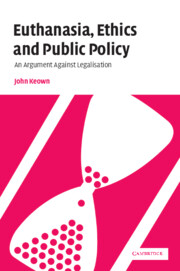Book contents
- Frontmatter
- Contents
- Preface
- Foreword
- Acknowledgments
- Table of cases
- List of abbreviations
- Introduction
- PART I Definitions
- PART II The ethical debate: human life, autonomy, legal hypocrisy, and the slippery slope
- PART III The Dutch experience: controlling VAE? condoning NVAE?
- 8 The guidelines
- 9 The first Survey: the incidence of ‘euthanasia’
- 10 Breach of the guidelines
- 11 The slide towards NVAE
- 12 The second Survey
- 13 The Dutch in denial?
- PART IV Australia and the United States
- PART V Expert opinion
- PART VI Passive euthanasia: withholding/withdrawing treatment and tube-feeding with intent to kill
- Conclusions
- Afterword
- Bibliography
- Index
12 - The second Survey
Published online by Cambridge University Press: 20 July 2009
- Frontmatter
- Contents
- Preface
- Foreword
- Acknowledgments
- Table of cases
- List of abbreviations
- Introduction
- PART I Definitions
- PART II The ethical debate: human life, autonomy, legal hypocrisy, and the slippery slope
- PART III The Dutch experience: controlling VAE? condoning NVAE?
- 8 The guidelines
- 9 The first Survey: the incidence of ‘euthanasia’
- 10 Breach of the guidelines
- 11 The slide towards NVAE
- 12 The second Survey
- 13 The Dutch in denial?
- PART IV Australia and the United States
- PART V Expert opinion
- PART VI Passive euthanasia: withholding/withdrawing treatment and tube-feeding with intent to kill
- Conclusions
- Afterword
- Bibliography
- Index
Summary
This chapter outlines and analyses the data from a second major Survey, carried out by Professor Van der Maas and Professor Van der Wal (an inspector of health), covering medical practice in the year 1995. A summary of the Survey was published in English the following year. The Survey sought particularly to ascertain the incidence of intentional life-shortening by doctors; the extent to which they complied with their duty to report such cases (in accordance with the procedure which was agreed between the KNMG and the Ministry of Justice in 1990 and given statutory force in 1994); and the quality of their reporting. The main purpose of the reporting procedure is, as the authors of the Survey acknowledged, to provide for possible scrutiny of the intentional termination of life by doctors and to promote careful decision-making in such cases. The most important quantitative data generated by the Survey are reproduced in Table 2.
It is important to note that, as with the first Survey, the only objectively verifiable figures are those concerning the total number of deaths and the total number of cases reported. All the other figures are based on the responses of the physicians concerning cases in which they said they had recently been involved. It is no less important to stress that this chapter does not question the methodology used by the researchers to obtain their data, namely, interviews with 405 physicians and postal questionnaires mailed to physicians who had attended 6,060 deaths identified from death certificates.
- Type
- Chapter
- Information
- Euthanasia, Ethics and Public PolicyAn Argument Against Legalisation, pp. 125 - 135Publisher: Cambridge University PressPrint publication year: 2002

